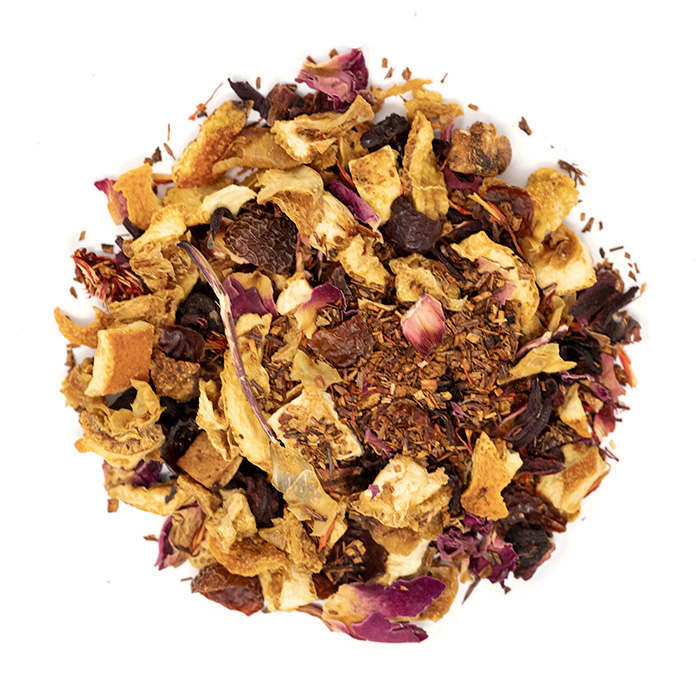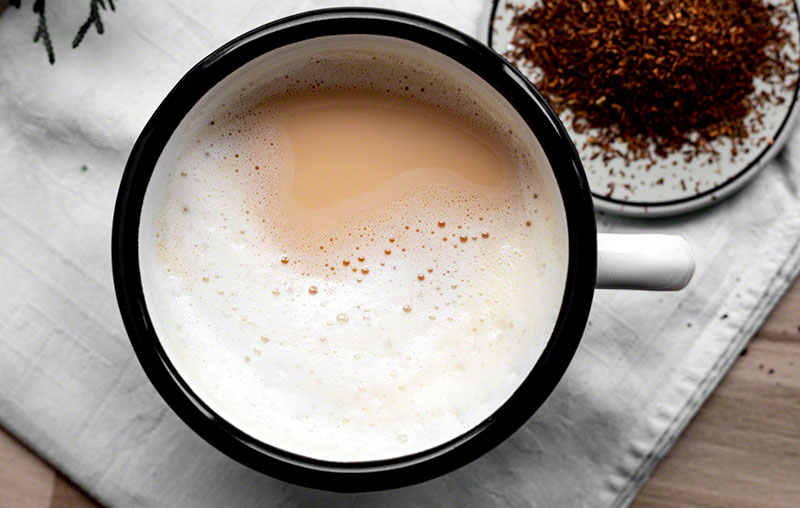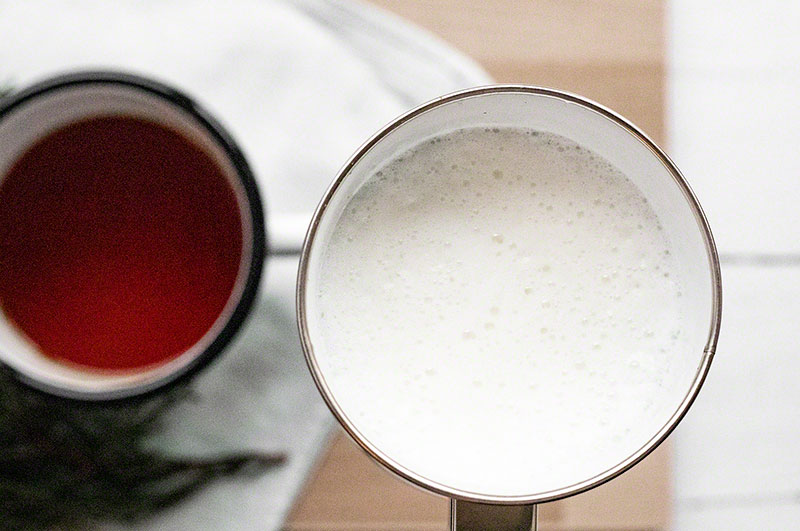5 Pure Red Rooibos Tea Recipes
Pure red rooibos tea may be an acquired taste, but with these few suggestions you will learn how to love it in no time. With many proven benefits and zero caffeine, rooibos is a great replacement for pure teas. However, to get the most benefits, you should be enjoying the tea you are drinking. Thankfully, rooibos is an extremely versatile tea, and you can use it in many ways.
What is red rooibos tea?
Red rooibos tea is an oxidized herbal tea made from aspalathus linearis, grown exclusively in South Africa. It can be both cultivated and wild. Rooibos has been made and used in South African countries for centuries, but the commercial production began less than 100 years ago[1]. The real popularity of rooibos tea in the western countries started almost at the same time as the popularity of flavored real tea blends. To an unfamiliar palate, rooibos may taste both unique and strange. The introduction of rooibos blends was the changing point in the perception of rooibos tea among western tea drinkers – and we should be immensely thankful for that. Why?
What are the red rooibos tea benefits?
Rooibos tea has many potential health benefits. It’s one of rare teas that is likely safe for infants and all other age groups. Rooibos has no caffeine at all. It’s abundant in antioxidants that help fight free radicals[2] and protect our bodies from internal and external damage. Rooibos may be beneficial in managing diabetes type 2, stress, blood pressure and bad cholesterol, and protect against heart diseases. Just like green tea, it has, antiviral, antibacterial and anti inflammatory properties. Animal studies suggest that rooibos may help liver in reducing the damage caused by toxins[3]. A few cups of rooibos tea may also do wonders for the skin. As a powerful antioxidant, rooibos may prevent the skin from sagging and becoming wrinkled, prevent skin cancers caused by UVB radiation[4] and help heal the wounds[5].

Blood Orange Rooibos tea blend
How to brew rooibos tea
To brew rooibos tea, you will need a teapot with a fine-mesh strainer, or a mug and a fine mesh infuser. Use fresh spring water and boil it in a clean kettle. Try not to boil the same water more than once. Let it cool for only a few seconds. Measure about 1 teaspoon of rooibos tea per cup of water. Steep for at least 5 minutes. The longer you steep, the better flavor you will get. Rooibos will never become bitter, so longer steeping is always a good idea with this tea, especially because you can’t re-use the same leaves. Drink immediately or let it cool down. Unlike green or oolong tea, the flavor of rooibos won’t change significantly.
5 Pure Red Rooibos Tea Recipes
If you cannot get used to drinking rooibos tea, you may still be able truly enjoy it in many ways.
1. Pure Rooibos Latte
Pure rooibos is perfect for making lattes, either pure or flavored. Unlike coffee or real tea, rooibos is caffeine free and suitable for any time of the day.
You will need:
- 2 teaspoons of pure rooibos tea
- 50 ml of water
- 200 ml of milk
- Honey or maple syrup
Instructions:
- Bring water to a boil and steep 2 teaspoons of pure rooibos tea in 50 ml of boiling water for 10 minutes
- Strain and pour into a mug
- In a saucepan, heat milk over a medium fire and whisk to make a froth
- Pour milk into a mug with steeped rooibos tea
- Add sweetener and stir
2. DIY Rooibos tea blend
Blending your own rooibos tea gives you an opportunity to create any blend you wish and experiment with new flavors every day. Use about 2/3 parts of pure red rooibos tea and 1/3 part of other ingredients. You can adjust the ratio of the base tea vs. other ingredients, but try to keep rooibos dominant. It blends perfectly well with chocolate flavors, citrus flavors and spices. Try blending it with white chocolate drops, a bit of crushed vanilla bean stick and some pecan nuts. Or, add freeze dried raspberries and dried mint.
3. Red Rooibos Syrup
Making a batch of red rooibos syrup will open a whole new world of opportunities to enjoy rooibos tea. Mix it with warm milk, add to cocktails or regular and rice puddings. You can even use it on pancakes and other desserts.
You will need:
- 5 teaspoons of rooibos tea
- ½ cup of sugar (around 100 grams)
- ½ cup of water
Instructions:
- Steep tea in ½ cup of boiling fresh spring water for about 10-15 minutes.
- Strain and add into a saucepan.
- Bring to a boil, reduce the heat and add sugar while stirring.
- When sugar has dissolved, remove from the heat and let it cool down.
- Keep in an airtight bottle or a jar in the fridge.
4. Rooibos Iced Tea
To make Rooibos Iced tea, brew a cup of hot rooibos tea same as if you were making a latte. Increase the steeping time and add a bit more leaves. Strain and add to a shaker filled with iced. Don’t forget to add a sweetener too. Maple syrup blends wonderfully with already naturally sweet rooibos. Shake for about a minute and serve.
5. Rooibos Smoothie
Rooibos contains no caffeine, but it can be a great ingredient for a morning energy boosting smoothie. For a Rooibos Banana Smoothie you will need:
- 2 teaspoons of pure rooibos tea
- 50 of water
- ½ cup of milk (or plain drinking yogurt)
- 1 banana (peeled and chopped)
- ½ mango (peeled and chopped)
- Honey if needed
Instructions:
Steep rooibos tea in 50 ml of freshly boiled spring water for 10 minutes and strain. You can make the tea even the night before and keep it in the fridge ready for the morning breakfast. Add all ingredients into a blender, starting with rooibos tea, mango, banana, sweetener and yogurt. Blend for 10-20 seconds and serve.
Disclaimer: This article is for informational purposes only. It’s not intended to replace medical advice, diagnosis or treatment. Every person is different and may react to different herbs and teas differently. Never use teas or herbs to treat serious medical conditions on your own. Always seek professional medical advice before choosing home remedies.
References:
[1] https://www.agriorbit.com/rooibos/
[2] http://cms.herbalgram.org/herbalgram/issue59/article2550.html?ts=1556917769&signature=9a55e2389cf79e70c8c20a0a2126ac6c
[3] https://www.hindawi.com/journals/omcl/2014/716832/





